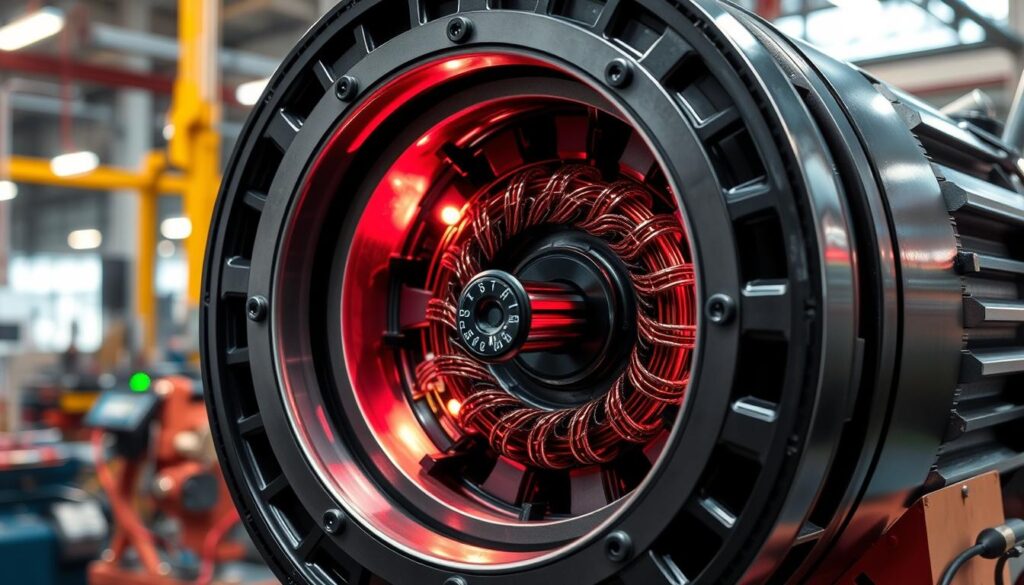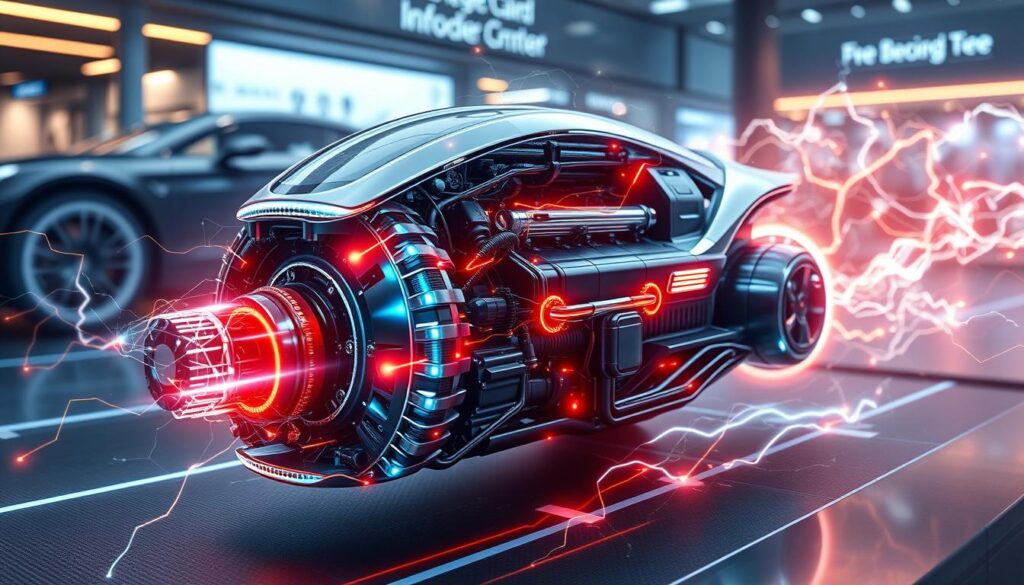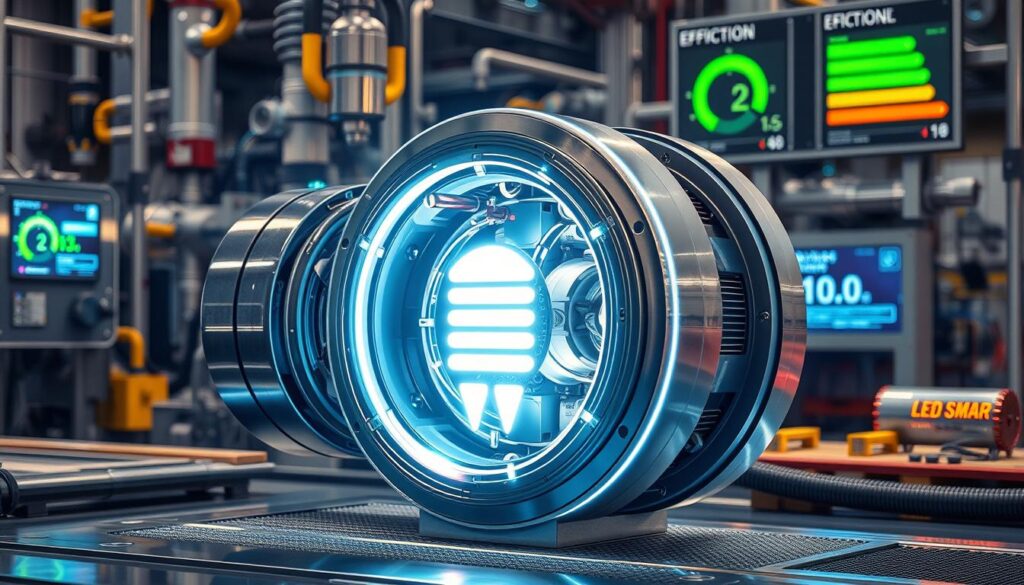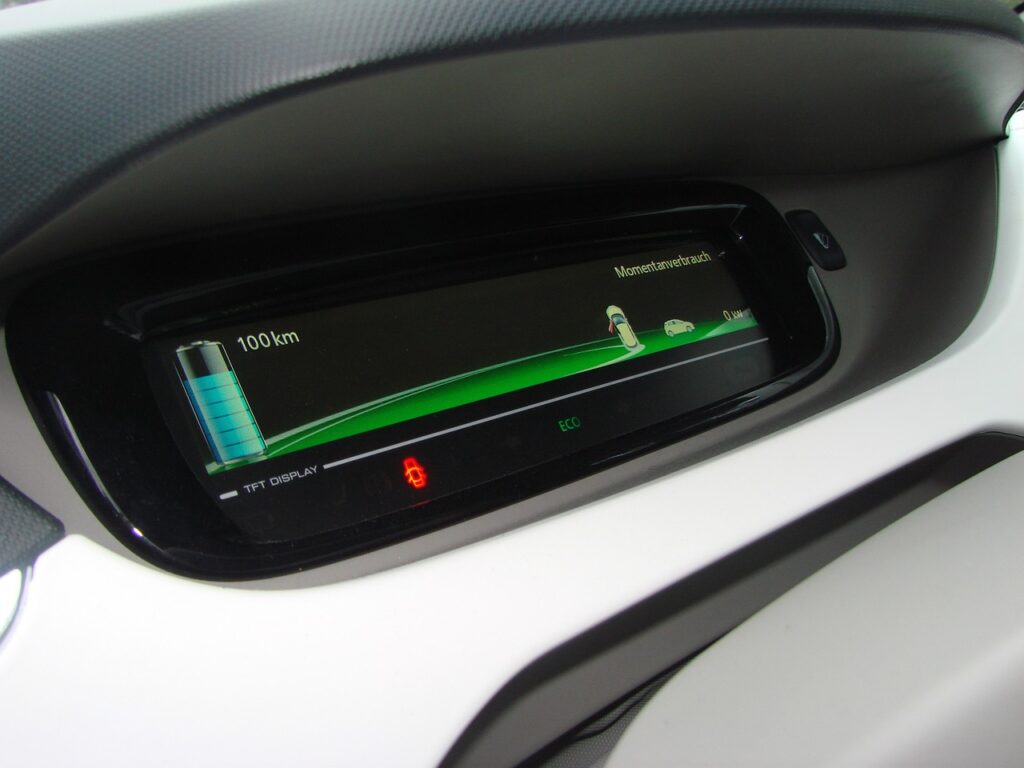In today’s fast-changing industrial world, electric motors are key. They power many machines and systems in different fields. From big production lines to energy-saving building systems, they are the top choice for reliable power.
The need for green and high-tech industrial systems is rising. This makes learning about electric motor technology very important. These solutions are changing how industries work and helping make systems more efficient and eco-friendly.

Key Takeaways
- Electric motors are essential power solutions for a wide range of modern industrial applications.
- They play a crucial role in driving efficiency, sustainability, and technological advancement in the industrial sector.
- Understanding the fundamentals and evolution of electric motor technology is crucial for industry professionals and decision-makers.
- Electric motors offer significant benefits in terms of energy efficiency, cost savings, environmental impact, and maintenance advantages.
- Emerging trends in electric motor technology, such as advancements in robotics and automation, are shaping the future of industrial power solutions.
Understanding Electric Motor Fundamentals and Basic Principles
Electric motors are key to modern industries. They power many things around us. To really get them, we need to know the basics.
From the different electric motor technologies to the core motor components and their mechanics, this section gives a deep dive into electric motors.
Types of Electric Motor Technologies
There are many electric motor technologies out there. Each has its own strengths and uses. Here are a few:
- Induction motors
- Synchronous motors
- Brushless DC motors
- Stepper motors
Core Components and Their Functions
Every electric motor has key parts. The stator makes the magnetic field. The rotor turns electrical energy into motion. The commutator controls the electrical flow.
Operating Principles and Mechanics
The operating principles of electric motors are based on electromagnetism. When electricity flows through the motor, it creates a magnetic field. This field interacts with the rotor’s field, making it spin.
This interaction is what makes electric motors so powerful. It’s a mix of electromagnetic forces and motion.
Knowing the electric motor basics, motor components, and motor operation lets us see their full potential. These motors are efficient and versatile.
The Evolution of Electric Motors in Industrial Applications
The history of electric motors is truly captivating. It’s filled with major breakthroughs that have changed how we work. From the first electric motors to today’s advanced ones, their role in shaping modern industry is huge.
The industrial motor history starts in the late 19th century. Nikola Tesla and Thomas Edison were key figures. Their work led to electric motors becoming common in many industries, like manufacturing and transport.
Over time, scientists and engineers kept making electric motors better. They improved materials, control systems, and energy use. This made electric motors smaller, stronger, and more efficient, making them a top choice for many uses.
Now, electric motors are everywhere in industry. They power big machines, production lines, HVAC systems, and more. Their growth has brought more efficiency, saved energy, and helped the environment in many ways.
“The electric motor has become the workhorse of modern industry, transforming the way we power and automate our factories and infrastructure.”
The story of electric motors shows the power of human creativity and innovation. Looking ahead, we can expect even more improvements in motor technology advancements and electric motor development. These will help make industries even more efficient and productive.
Benefits of Electric Motors in Modern Manufacturing
The manufacturing world is changing fast, and energy-efficient motors are leading the way. These motors bring many benefits, like saving money and helping the planet. They’re changing how factories work today.
Energy Efficiency and Cost Savings
Using energy-efficient motors cuts down on energy use a lot. They work better and waste less energy, saving businesses a lot of money. This lets companies spend more on important things instead of just keeping the lights on.
Environmental Impact and Sustainability
Nowadays, making things in a green way is key, and electric motors help a lot. They use less energy than old motors, making factories cleaner. This makes customers happy too, because they want products made in a way that’s good for the planet.
Maintenance and Longevity Advantages
Electric motors also mean less upkeep and last longer. They work hard and need less fixing, which means factories can keep running smoothly. This makes making things cheaper and more efficient over time.
By using energy-efficient electric motors, factories can make things better, cheaper, and greener. As things keep changing, these motors will keep being a big help. They’re key to making factories better for the planet and more efficient.
| Benefit | Description |
|---|---|
| Energy Efficiency | Energy-efficient electric motors significantly reduce energy consumption, leading to substantial cost savings for manufacturing operations. |
| Environmental Sustainability | The use of energy-efficient electric motors aligns with sustainability goals, contributing to a lower carbon footprint and more eco-friendly manufacturing processes. |
| Maintenance and Longevity | Electric motors offer reduced maintenance requirements and extended lifespan, enhancing the overall cost-effectiveness and productivity of manufacturing facilities. |
Electric Motors in Cars: Current Trends and Innovations
The car industry has seen big changes in electric motor tech. This has brought in a new era of electric vehicle motors. These motors, powered by the latest tech, are changing how we travel.
Now, there’s a big focus on making these motors more efficient and powerful. Car makers are working hard to make motors that go further, accelerate quicker, and handle better. These improvements make driving better and help the environment too.
The tech behind these motors is getting smarter. It includes advanced control systems, regenerative braking, and smart battery management. These features help use energy better, make batteries last longer, and give drivers a smooth ride.
As more people want electric cars, the need for good motors is huge. Car companies are spending a lot on research to make even better motors. This will help electric cars become the norm in the future.

In short, the progress in electric vehicle motors, automotive electric technology, and EV motor trends is changing the car world. As people care more about the planet and laws get stricter, we’ll need even more green and smart motor solutions.
| Key Trends in EV Motor Technology | Benefits |
|---|---|
| Increased Energy Efficiency | Improved Range and Performance |
| Advanced Control Systems | Optimized Energy Usage and Battery Life |
| Regenerative Braking | Enhanced Driving Experience and Sustainability |
Industrial Applications and Use Cases
Electric motors are key in many industrial areas. They power important systems and help with new technologies. Their ability to work in many places shows how they’ve changed industries.
Heavy Manufacturing and Production Lines
In heavy manufacturing, electric motors are crucial. They drive big machines, conveyor belts, and more. Their strong performance and energy saving help keep work flowing without stops.
Industrial motor applications include big stamping presses and robotic welding. This makes production smoother and more efficient.
HVAC Systems and Building Automation
The HVAC industry benefits a lot from electric motors. HVAC motors run fans, compressors, and pumps. They keep buildings comfortable and air clean.
Electric motors also control building systems. They manage lights, security, and more. This makes buildings run smoothly and safely.
Robotics and Automation Solutions
Robotics and automation have grown thanks to electric motors. These motors give robots the control and speed they need. They help with tasks like picking up items and assembling parts.
Electric motors have made automation better. They bring more efficiency and accuracy to work.
“Electric motors have become the backbone of modern industry, powering a wide array of critical systems and enabling groundbreaking technological advancements.”
Efficiency Standards and Regulatory Compliance
In the world of industrial manufacturing, following strict motor efficiency regulations and energy standards is crucial. These rules, set by regulatory bodies, push for innovation and better energy use. They also help reduce the environmental impact of electric motors in different industrial applications.
The International Electrotechnical Commission’s (IEC) IE code system is well-known. It sorts motors by their energy use. Motors rated IE2, IE3, or IE4 are high-efficiency, saving a lot of energy and cutting costs for factories.
- IE2 motors are considered “high-efficiency” and can achieve up to 4% energy savings compared to standard motors.
- IE3 motors, or “premium-efficiency” models, can save up to 6% in energy consumption.
- The newest IE4 “super-premium-efficiency” motors can deliver up to 8% in energy savings.
There are also local and national rules, like the United States’ NEMA Premium Efficiency program and the European Union’s Ecodesign Directive. These rules set specific efficiency levels for electric motors in various industries. Following these regulations cuts energy costs and helps the environment by reducing greenhouse gas emissions.
As the need for energy-efficient and eco-friendly products grows, makers must keep up with the latest motor efficiency regulations and energy standards. This ensures their products meet the needed standards and stay competitive.

“Efficiency standards are not just about energy savings; they’re about creating a more sustainable future for our industries and our planet.”
Maintenance Best Practices and Troubleshooting
Keeping electric motors in top shape is key for their best performance and life span. By sticking to the best maintenance practices and fixing common problems, your motors will keep running smoothly and reliably. Let’s dive into the main points of electric motor care and fixing issues.
Common Issues and Solutions
Electric motors can run into many issues, from winding failures to bearing problems. Here are some common problems and how to solve them:
- Overheating: Make sure there’s good air flow, clean air filters, and the motor isn’t too heavy.
- Vibration: Check the motor shaft, replace old bearings, and make sure it’s installed right.
- Insulation breakdown: Do regular insulation tests and fix any problems fast.
- Bearing failure: Use the right lubricant and replace bearings when needed.
Preventive Maintenance Schedules
Having a solid preventive maintenance plan is vital for your electric motors’ performance and life. This plan should include:
- Regular checks: Look for wear, damage, or odd behavior.
- Cleaning and lubrication: Keep the motor clean and lubricate bearings as advised.
- Electrical tests: Do insulation, winding, and other electrical tests.
- Vibration analysis: Watch for any changes in vibration.
Performance Optimization Tips
To get the best performance and energy use, try these tips for electric motor optimization:
- Choose the right motor size: Avoid using a motor that’s too big, as it wastes energy.
- Use variable-speed drives: They can greatly cut energy use in changing load situations.
- Keep the motor aligned and balanced: This helps reduce energy loss.
- Switch to energy-saving motor models: New, efficient motors can save a lot of energy.
By following these electric motor maintenance, troubleshooting, and optimization tips, you can make your motors more reliable, efficient, and long-lasting. This will help your operations succeed.
Future Trends in Electric Motor Technology
The electric motor industry is on the brink of major breakthroughs. Experts foresee a future where advanced designs, new materials, and smart control systems lead the way. These advancements promise better efficiency, less energy use, and reliability across various fields, from manufacturing to electric cars.
High-performance permanent magnet motors are a key trend. They use rare-earth magnets for high power and efficiency. This makes them ideal for compact, high-torque needs. Researchers are also looking into switched reluctance motors, which are cheaper and easier to maintain.
Another exciting trend is the use of advanced control systems and power electronics. Smart algorithms and control strategies can improve motor performance and reduce energy use. The addition of IoT technologies and predictive maintenance will also help monitor and maintain motors better, reducing downtime and boosting efficiency.
FAQ
What are the key benefits of using electric motors in modern manufacturing?
Electric motors bring many benefits to modern manufacturing. They improve energy use, save costs, and are better for the environment. They also last longer and need less maintenance.
What are the different types of electric motor technologies available?
There are many electric motor technologies. These include induction motors, synchronous motors, brushless DC motors, and stepper motors. Each has its own features and uses.
How have electric motors evolved in industrial applications over time?
Electric motors have made big strides in history. They’ve become key in many industries thanks to important innovations and milestones.
What are the common issues and best practices for maintaining electric motors?
Keeping electric motors in good shape is important. This means regular maintenance, fixing problems, and making them work better. It’s all about keeping them running smoothly and efficiently.
How are electric motors used in the automotive industry, and what are the current trends and innovations?
Electric motors are crucial in the car world, especially for electric vehicles. The industry is seeing new tech and improvements in electric motor design. These changes aim to make cars better and more efficient.
What are the key industrial applications and use cases for electric motors?
Electric motors are used in many ways in industry. They power heavy machinery, HVAC systems, and robots. They’re essential for keeping things running smoothly in many settings.
What are the efficiency standards and regulatory requirements for electric motors?
Electric motors must meet certain standards and rules. These help make them more energy-efficient and ensure they work well in different places.
What are the future trends and emerging technologies in the field of electric motor design?
The world of electric motors is always changing. Scientists and makers are working on new designs, materials, and control systems. Their goal is to make motors better, more efficient, and ready for new uses.


Pingback: Ultimate Guide to Hybrid Cars: Save Money & Go Green
Pingback: The history of electric motors Since 1800s
Pingback: Gas vs Electric Car Impact: What You Need to Know
Pingback: Electric vs Gas Car Cost - Compare True Expenses